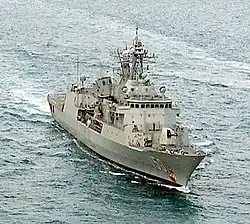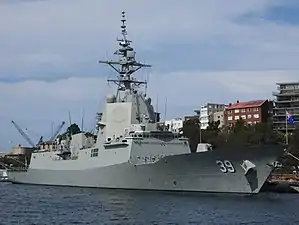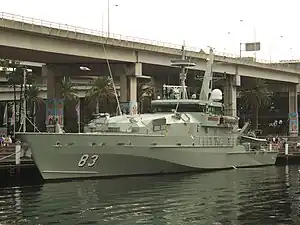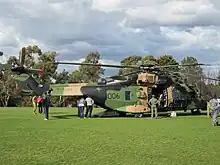Future of the Royal Australian Navy
The Royal Australian Navy, although a significant force in the Asia-Pacific region, is nonetheless classed as a medium-sized navy. Its fleet is based around two main types of surface combatant, with limited global deployment and air power capability. However, in 2009, a white paper, Defending Australia in the Asia Pacific Century: Force 2030, was produced by the Australian government which set out a programme of defence spending that will see significant improvements to the RAN's fleet and capabilities.
Future vessels
The following is a list of vessels currently ordered or under construction for the Royal Australian Navy:
| Class | Ship | Pennant No. | Builder | Type | Displacement | Launched | Commissioning | Status |
|---|---|---|---|---|---|---|---|---|
| Arafura class | Arafura | OPV 203 | ASC Shipbuilding, Osborne | Offshore patrol vessel | 1,640 tonnes | 16 December 2021 | 2024[1] | Fitting out |
| Eyre | OPV 204 | 2022 | 2023?[2] | Fitting out | ||||
| Pilbara | OPV 205 | Civmec, Henderson | 2023? | 2023?[3] | Under construction | |||
| Gippsland | OPV 206 | 2024[4] | February 2024[3] | Under construction | ||||
| Illawarra | OPV 207 | December 2024[3] | Under construction | |||||
| Carpentaria | OPV 208 | June 2025[3] | Ordered | |||||
| TBD | April 2026[3] | |||||||
| TBD | January 2027[3] | |||||||
| TBD | October 2027[3] | |||||||
| TBD | June 2028[3] | |||||||
| TBD | March 2029[3] | |||||||
| TBD | December 2029[3] | |||||||
| Cape class | Cape Pillar | 317 | Austal, Henderson | Patrol boat, general | 400 tonnes | 2023 | Fitting out | |
| ADV Cape Schanck | 2024 | Under construction | ||||||
| ADV Cape Solander | 2024 | Under construction | ||||||
| Hunter class | Hunter | BAE Systems Australia and ASC Shipbuilding, Osborne | Frigate, guided missile | 10,000 tonnes | 2032 | Ordered | ||
| Flinders | ||||||||
| Tasman | ||||||||
| TBD | Planned | |||||||
| TBD | ||||||||
| TBD | ||||||||
| TBD | ||||||||
| TBD | ||||||||
| TBD | ||||||||
| Sail training ship | Young Endeavour II | Birdon Group | Barquentine | N/A | Under construction | |||
The following is a list of vessels currently planned for the Royal Australian Navy:
| Class | Ship | Pennant No. | Builder | Type | Displacement | Launched | Commissioning | Status |
|---|---|---|---|---|---|---|---|---|
| Mine countermeasures vessel class[6] | TBD | Mine countermeasures vessel | N/A | |||||
| TBD | ||||||||
| TBD | ||||||||
| TBD | ||||||||
| TBD | ||||||||
| TBD | ||||||||
| TBD | ||||||||
| TBD | ||||||||
| Multi-role sealift and replenishment vessel class | TBD | N/A | ||||||
| TBD | ||||||||
| ADV Ocean Protector replacement | TBD | N/A | ||||||
| Salvage and repair vessel | TBD | N/A | ||||||
| SSN-AUKUS | TBD | Osborne | Attack submarine, nuclear-powered | N/A | ||||
| TBD | ||||||||
| TBD | ||||||||
| TBD | ||||||||
| TBD | ||||||||
| Virgina Class | TBD | TBA | Attack submarine, nuclear-powered | 7,900 tonnes | ||||
| TBD | ||||||||
| TBD | ||||||||
Surface combatants
Anzac-class FFH

The Anzac class is the main surface combatant of the Royal Australian Navy. The first unit was commissioned in 1996 and the last entered service in 2006. Starting in November 2003, all eight frigates underwent extensive upgrades under Project SEA 1448 Phase 2, the Anzac Ship Anti-Ship Missile Defence upgrade. Completed in two phases, the following systems were upgraded and installed:
- Upgrade to the Saab Systems 9LV 453 Combat Management System.
- Installation of a SAGEM Vampir NG Infra-Red Search and Track System capable of detecting anti-missile and low-flying aircraft near land.
- Installation of an Australian CEAFAR S-band phased array radar and CEAMOUNT X-band multi-channel phased array missile illuminator to deliver enhanced target detection and better tracking, allowing Evolved Sea Sparrow missiles to engage multiple targets simultaneously.
- Installation of an I-Band navigation radar to replace existing target indication and Krupp Atlas 9600 radar systems.
Final Operating Capability is scheduled for October 2017.[7][8][9] The vessels are expected to remain in service until 2032 where they will be replaced with up to nine frigates designed primarily for anti-submarine warfare.[10] Further upgrades under the so-called AMCAP upgrade include the replacement of the ageing Air Search Radar capability with the new CEAFAR L-band long-range air search radar. Designed and produced by CEA Technologies, this new radar technology will also be part of the combat system on board the Hunter-class frigates which will replace the Anzac-class frigates. Other major work as part of AMCAP upgrade include:
- Upgraded ventilation systems; new sewage systems;
- Improvements to the Control and Monitoring System;
- Engine modifications to improve power and efficiency;
- New communications suite (SEA1442);
- Upgraded LESCUT;
- Upgraded AN/SLQ-25C torpedo self-defence systems; and
- Technical insert for the Saab 9LV 453 combat management system moves its operating system from Windows to Linux.[11]
Hobart-class DDG

The most significant project recently completed for the RAN are three Hobart-class air warfare destroyers to replace the Adelaide-class frigates. Although the 2009 Defence White Paper and original contract suggested that a fourth ship may be ordered, the 2016 Defence White Paper concluded that only three would be built. Each destroyer will be fitted with the Aegis combat system and will be based on the F100 design by Spanish shipbuilding company Navantia. Each vessel will be fitted with cruise missiles and the SM-6 anti-aircraft missile. Hobart was commissioned on 23 September 2017, with the following vessels to be delivered in 2018 and 2019. The destroyers are being built by ASC Pty Ltd, although the project involves a significant amount of work sub-contracted to other companies and locations.[12] The destroyers are to be named Hobart, Brisbane and Sydney. Future upgrades to this class includes an upgraded Aegis Combat System with an Australian developed tactical interface which will be the same as on the Hunter-class FFG.[13] Future potential upgrades include the integration of the SM-6 and the acquisition of the Naval Strike Missile as a replacement of the RGM-84 Harpoon anti-ship missile. The government will invest up to $5.1 billion in upgrades to the Hobart-class destroyer combat management system upgrades at Osborne from 2024.[14]
Hunter-class FFG
With the Anzac-class frigates due to begin retiring in the late 2020s, work on a replacement program has begun. The program is expected to cost AU$35 billion and a request for tender for the vessel design was released in March 2017 to three contenders: Navantia, Fincantieri, and BAE Systems as part of a competitive evaluation process. In June 2018, Prime Minister Malcolm Turnbull announced that a variation of the BAE design had been selected as the preferred tender for the Hunter-class frigates.[15] Construction will begin in Adelaide, South Australia in 2020.[16] Australian shipbuilding company ASC Shipbuilding will become a subsidiary of BAE Systems Australia for the duration of the build.[17]
Amphibious warfare

The RAN's amphibious capabilities was greatly increased by a new class of two Canberra-class amphibious vessels. These ships, based on Navantia's Strategic Projection Ship (later commissioned into the Spanish Navy as Spanish ship Juan Carlos I), displace approximately 27,000 tonnes, can transport 1,000 personnel and 150 vehicles, and can transport these ashore through landing craft carried in a well deck, or helicopters, with up to six operating simultaneously from each ship's flight deck. The new ships, named HMAS Canberra and HMAS Adelaide, their hulls were built at Navantia's shipyard in Spain, then transported to BAE Systems Australia (BAE acquired Tenix Defence after contract awarded) facilities at Williamstown, Victoria for finishing. The two ships replaced the Kanimbla-class amphibious vessels. HMAS Tobruk was to be replaced by a strategic sealift vessel of 10,000 to 15,000 tons displacement, which will provides the capacity to transport equipment, supplies, helicopters, and soldiers into zones of operation, and embark or disembark these without port facilities. .In the 2016 defence white paper it revealed that HMAS Choules would fulfill this role. Following the early decommissioning of both Kanimblas and Tobruk being out of action, multiple ships were purchased and or leased to cover the lack of amphibious capability. The RAN planned also replace the six Balikpapan-class heavy landing craft with six larger vessels. In mid-2011, the RAN acquired the former British Royal Fleet Auxiliary landing ship RFA Largs Bay, which entered service in December 2011 as HMAS Choules.
Minor vessels

Between 1999 and 2003, the RAN acquired six Huon-class minehunters.[18] Based on Intermarine's Gaeta-class minehunters, each ship is equipped with a variable depth sonar, and a pair of Bofors Double Eagle underwater clearance vehicles.[18]
The RAN's main patrol force is the Armidale class. The first of these, HMAS Armidale, was commissioned in June 2005, and was the first of fourteen. HMAS Glenelg, the last ship of the class was commissioned in 2008. Two ships have been decommissioned. HMAS Bundaberg in 2014 as a result of extensive damage caused by a fire and HMAS Pirie in 2021.[19]
The 2009 Defence White Paper announced that a new class of 20 offshore combatant vessels would replace the Armidale and Huon classes, along with the Leeuwin and Paluma-class survey ships.[20] The multi-role ships are predicted to displace anywhere up to 2,000 tonnes, and may be equipped with a helicopter or unmanned aerial vehicle.[20] However the 2016 Defense White Paper decreased the amount of planned vessels to twelve and stated that they would only replace the Armidales while the other classes would see life-extension work. Lurssen's OPV 80 design was chosen. The class was named Arafura-class offshore patrol vessel (OPV). The first ship will be named Arafura.
During the 2019 election campaign, Scott Morrison announced that one hydrographic survey ship and two minehunters would be constructed from the mid 2020s in the Henderson Shipyard Precinct Under SEA 1905 and SEA 2400. SEA 2400 Hyrdographic Data Collection Capability Program which includes the introduction of a Strategic Military Survey Capability (SMSB) to replace the Leeuwin-class survey vessels. While SEA 1905 is the acquisition of a further two Arafura-class offshore patrol vessels in a mine counter-measures configuration.[21][22] This was expanded in the 2020 Defence Strategic Update and 2020 Force Structure Plan released on the 30 June 2020 for up to 8 vessels optimised for mine countermeasures and hydrographic survey roles potentially based on the Arafura design.
The Government announced that six evolved Cape-class patrol boats from Austal to be built in Henderson, Western Australia will be acquired for A$350 million on 1 May 2020 to boost patrol capability.[23]
Submarines

The Collins-class submarines, the first of which entered service in 1996, are due to receive a major upgrade to their combat systems, with technology based on the US Navy's Virginia class. This new system will be introduced in conjunction with the new heavyweight torpedo.
In the longer term, the Collins-class submarines will begin to reach the end of their useful life in 2026.[24] To meet an in-service date of 2026, advanced design work on the next generation of Australian submarines will begin by 2014–2015. The submarines are likely to be Australian-built, conventional submarines equipped with air independent propulsion and advanced combat and communications systems.[25] Defence Minister Joel Fitzgibbon ordered planning to begin on the next generation of submarines to replace the Royal Australian Navy's Collins-class fleet. The 17-year project will be the largest, longest and most expensive defence acquisition since Australia's Federation, potentially costing up to $25 billion. The submarines are expected to be capable of carrying long-range cruise missiles and midget-subs.[26]
According to the 2009 Defence White Paper, the submarine fleet is to be expanded to 12. The submarines will be equipped with cruise missiles and the world's most advanced torpedoes, sonars, combat systems, intelligence gathering systems as well as also being able to support special forces operations. The first submarine is expected to be in service by 2030. The 2009 White Paper predicted the cost of the new submarines at $35 billion.
Collins class
To avoid a capability gap prior to the anticipated entry into service of the first of 12 Attack-class submarines, Defence Minister Peter Dutton has confirmed that all 6 of the Collins-class submarines will undergo major life-of-type extensions (LOTEs). Approximately $6 billion would be invested in the program. It is expected to involve rebuilding each submarine once it achieves 30 years of service, with each upgrade scheduled to take approximately two years.[27]
SSN-AUKUS
On 15 September 2021, Australian, US, and UK leaders announced the AUKUS agreement which included the construction of nuclear powered submarines for the RAN replacing the previous plan to acquire 12 French designed diesel-electric powered Attack-class submarine[28] A specific plan for the acquisition of nuclear-powered submarines was outline in March 2023 and will proceed in three phases.
In the first phase RAN personnel will be trained by the US and UK, while Australia develops submarine shipyard infrastructure and maintenance facilities. Starting in 2027 the US and UK will deploy Virginia-class and Astute-class submarines to Australia as part of "Submarine Rotational Force West". The second phase, starting from 2032, will then see the RAN acquire three Virginia-class submarines, with the option to acquire two more. The final phase will involve Australia and the United Kingdom jointly developing the SSN-AUKUS. Australia will build five SSN-AUKUS boats by 2055 and eight by the mid 2060s.[29] [30]
Afloat Support
The RAN currently has two ships used for afloat support/replenishment at sea: HMAS Supply and HMAS Stalwart. Supply, replaced the former support ship HMAS Success in April 2021, while Stalwart replaced the fleet oiler HMAS Sirius in November 2021. Supply and Stalwart are based on the Navantia built Spanish Navy's replenishment vessel Cantabria.[31]
The 2020 Defense Strategic Update And 2020 Force Structure Plan announced the planned procurement of two new additional multi-role sealift and replenishment ships, a replacement of the ADV Ocean Protector, a large salvage and repair vessel, a replacement for STS Young Endeavour youth training ship and a new vessel to support the Pacific Step-Up.[32] The two announced multi-role sealift and support ships - Project Sea2200 - would be domestically built and replace HMAS Choules and enhance the logistical support of the RAN. [33] As of May 2022 BMT Group was the sole company having submitted a proposal based on their ELLIDA design, adapted from the Royal Fleet Auxiliary designated as Tide Class, however the Damen Group reportedly had also shown interest in submitting a design based on their joint support ship class.[34]
Fleet Air Arm

The Fleet Air Arm is currently an all rotary winged organisation. The RAN operates 6 MRH-90 helicopters shared with the Australian Army,[35] and 23 MH-60R "Romeo" Seahawk helicopters.
The US government has approved a possible sale of up to 12 additional MH-60R helicopters to the RAN. This is part of the RAN plan to expand and rationalise its support and logistics helicopter fleet by replacing the 6 MRH-90s and operating only one type of helicopter to ease maintenance and training.[36][37] In May 2022, the Morrison government announced that it would purchase 12 MH-60Rs to replace the MRH-90 fleet and a 13th to replace a MH-60R that was ditched in the Philippine Sea in October 2021.[38][39] In September 2022, the Albanese government placed an order for 12+1 MH-60Rs.[40]
List of major projects
(Updated to reflect changes made in the Defence Capability Plan – June 2011 Supplement)
- JP 2048 – Amphibious Deployment and Sustainment program
- Phase 5: Balikpapan-class landing craft replacement – 6 new LCH design
- Sea 1000 – Design and Procurement of Future Submarine
- Phase 1 & 2: Phase 1 (Design) and Phase 2 (Acquisition) has been combined. Decision not due until 2017–2020 or so.
- Sea 1180 – Arafura-class offshore patrol vessel.
- Sea 1360 – Maritime Extended Range Air Defence (Standard SM-6 for Hobart-class destroyer)
- Phase 1: Project definition stage. Budget for capability reduced from $1–$2b to $500m-$1b.
- Sea 1439 – Installation of new combat system for Collins-class submarines
- Phase 4A: Replacement Combat System.
- Currently underway, IOC has been achieved and FOC expected by 2013.
- Replacement system is the same AN/BYG-1v8 system fitted to the Virginia-class SSN.
- Phase 4B: Weapon & Sensor Enhancements.
- Currently underway.
- Phase 6: Sonar Replacement.
- Given first-pass approval.
- Phase 4A: Replacement Combat System.
- Sea 1448 – Anzac-class frigate capability upgrades
- Phase 2B: Anzac-class Anti-Ship Missile Defence upgrade
- HMAS Perth successfully completed trials of ASMD upgrade in July 2011.
- The upgrade of the other seven Anzac-class frigates has been given government approval.[42] The upgrade is due to begin early 2012 and be complete by 2017.
- Phase 4A: ES system improvement given first-pass approval.
- Phase 4B: AN/SPS-49 (Air Search Radar) replacement budget increased from $100–$300m to $300–$500m.
- RFI released.
- Phase 2B: Anzac-class Anti-Ship Missile Defence upgrade
- Sea 1654 – Maritime Operational Support Capability
- Phase 3: HMAS Success replacement
- Keel laid for HMAS Supply on 18 November 2017; she commissioned in April 2021. Second vessel of the class, HMAS Stalwart, commissioned in November 2021.
- Phase 3: HMAS Success replacement
- Sea 5000 – Future Frigate Program – (Anzac-class frigate replacement)
- Phase 1: Project definition stage. Contract awarded to BAE Systems Australia June 2018, 9 ships to enter service 2027 - 2042[43]
- SEA 1905 is the acquisition of a further two Arafura-class offshore patrol vessels in a mine counter-measures configuration.[21]
- SEA 2400 is the Hydrographic Data Collection Capability Program which includes the introduction of a Strategic Military Survey Capability (SMSB) to replace the Leeuwin-class survey vessels.[21]
- SEA 2200 - Future joint support ship
- Initial designs sought for two joint support ships to replace HMAS Choules and be construct domestically.[34]
A full listing of all current projects is available at the Defence Materiel Organisation website.
Recently completed projects
- JP 3030 – HMAS Choules procurement
- JP 2048 – Amphibious Deployment and Sustainment program
- Sea 4000 – Design and procurement of new Air Warfare Destroyers
- Air 9000 – Future Naval Aviation Combat System
Notes
- Parker, Jennifer (27 September 2023). "With delay of fleet review, RAN must be prepared to fight with what it has now". ASPI. Australian Strategic Policy Institute. Retrieved 5 October 2023.
- "New patrol boats hit with six-month delay". Australian Financial Review. 26 July 2021. Retrieved 31 August 2021.
- feed-importer (25 June 2019). "Defence's Procurement of Offshore Patrol Vessels — SEA 1180 Phase 1". www.anao.gov.au. Retrieved 20 August 2021.
- https://www.gippslandtimes.com.au/story/6902917/hmas-gippsland-expected-to-be-launched-in-2024/
- Andrew McLaughlin (30 June 2020). "Govt outlines expansion of Australian Defence Firepower". ADBR. Retrieved 21 December 2020.
- "Anzac Ship Anti-Ship Missile Defence". Department of Defence (Australia). December 2014. Retrieved 16 May 2017.
- Rahmat, Ridzwan (18 August 2016). "ANZAC frigate HMAS Toowoomba begins anti-ship missile defence upgrades". IHS Jane's 360. Archived from the original on 19 August 2016. Retrieved 16 May 2017.
- "Anzac Ship Anti-Ship Missile Defence". Department of Defence (Australia). December 2014. Retrieved 16 May 2017.
- "Anzac Class Frigate". Department of Defence (Australia). December 2014. Retrieved 16 May 2017.
- "Australian Anzac-class Frigates upgrade program rolls on". 9 June 2020.
- Navy unveils $11b warship contract ABC News 20 June 2007
- "RAN Hobart-class Destroyers Set for Aegis Combat System Upgrade". 3 September 2020.
- "Key naval projects confirmed for South Australia | Prime Minister of Australia". Archived from the original on 30 September 2021. Retrieved 30 September 2021.
- Taylor, Rob (28 June 2018). "Australia's $26 Billion Warship Deal Goes to Britain's BAE". The Wall Street Journal. Canberra, Australia. Retrieved 28 June 2018.
- "Future Frigate". Department of Defence (Australia). September 2016. Retrieved 16 May 2017.
- Tillett, Andrew (28 June 2018). "Rule Britannia as Malcolm Turnbull chooses UK design for $35b frigate contract". Australian Financial Review. Retrieved 28 June 2018.
- Saunders, Stephen, ed. (2008). Jane's Fighting Ships 2008–2009. Jane's Fighting Ships (111th ed.). Surrey: Jane's Information Group. p. 32. ISBN 978-0-7106-2845-9. OCLC 225431774.
- "HMAS Pirie II". Royal Australian Navy. Retrieved 1 October 2021.
- Department of Defence (2 May 2009). Defending Australia in the Asia Pacific Century: Force 2030. Commonwealth of Australia. pp. 72–3. ISBN 978-0-642-29702-0. OCLC 426475923.
- "Draft Strategic Infrastructure & Land Use Plan" (PDF). Western Australian Government. 18 June 2020.
- "Navy warships to be built in Perth under Coalition election pledge worth $1b". www.abc.net.au. 29 April 2019. Retrieved 30 June 2020.
- "Navy to get new patrol boats to boost capability - Defence Connect". 30 April 2020.
- "Australia's Future Underwater Warfare Capability – Project SM 2020". Submarine Institute of Australia. Archived from the original on 20 August 2006. Retrieved 17 September 2006.
- Patrick Walters (2006). Cutting Edge: The Collins experance. Australian Security Policy Institute, Canberra. Pages 10–11.
- Stuart, Cameron (26 December 2007). "Navy to get new lethal submarine fleet". The Australian. Archived from the original on 26 December 2007.
- "Collins Class fleet to receive $6bn service life extension". www.defenceconnect.com.au. 11 June 2021. Retrieved 17 July 2021.
- scheme=AGLSTERMS. AglsAgent; corporateName=Commonwealth of Australia, Department of Defence; address=Russell Offices. "Nuclear-Powered Submarine Task Force | About | | Department of Defence". www1.defence.gov.au. Retrieved 16 September 2021.
{{cite web}}: CS1 maint: multiple names: authors list (link) - Sevastopulo, Demetri; Cameron-Chileshe, Jasmine (13 March 2023). "Aukus allies unveil plan to supply Australia with nuclear-powered submarines". Financial Times. Retrieved 14 March 2023.
- Galloway, Anthony (14 March 2023). "Eight submarines, three decades, up to $368 billion: Australia's historic AUKUS plan at a glance". Sydney Morning Herald. Retrieved 14 March 2023.
- Grevatt, Jon (10 March 2016). "Australia selects Navantia for new replenishment ship". IHS Jane's 360. Archived from the original on 13 March 2016. Retrieved 4 December 2018.
- "Australia Issues 2020 Defense Strategic Update and 2020 Force Structure Plan". July 2020.
- ANI. "Supply ship details emerge | The Australian Naval Institute". Retrieved 12 August 2022.
- Felton, Benjamin (13 May 2022). "New Details Emerge on Australia's Future Joint Support Ship". Naval News. Retrieved 12 August 2022.
- "MRH 90 to Replace Sea King and Black Hawk Helicopters". www.minister.defence.gov.au. Archived from the original on 27 August 2006.
- Andrew McLaughlin (8 October 2021). "Australia approved to buy additional MH-60R helicopters". ADBR. Retrieved 13 October 2021.
- Department of Defence (2020). 2020 Force Structure Plan (PDF). Commonwealth of Australia. p. 37. ISBN 9780994168061. Archived (PDF) from the original on 13 April 2021. Retrieved 2 October 2021.
- Prime Minister Scott Morrison; Minister for Defence Peter Dutton; Minister for Defence Industry, Minister for Science and Technology Melissa Price (9 May 2022). "Securing our national security and local defence jobs and skills". Liberal Party of Australia (Press release). Archived from the original on 9 May 2022. Retrieved 1 September 2022.
- "Three aircrew safe after helicopter ditched in the Philippine Sea". Department of Defence (Press release). 14 October 2021. Archived from the original on 21 October 2021. Retrieved 9 January 2022.
- "Lockheed Martin to produce 12 more MH-60R Seahawk Helicopters for the Royal Australian Navy". Lockheed Martin (Press release). 20 September 2022. Retrieved 5 October 2022.
- Brown, Phill (30 June 2011). "Amphibious Deployment & Sustainment Program" (PDF). Archived from the original (PDF) on 27 February 2012. Retrieved 16 August 2011.
- Clare, Jason (28 November 2011). "New Cutting Edge Missile Defence System for ANZAC Ships". Department of Defence. Archived from the original on 27 February 2012. Retrieved 28 November 2011.
- Here comes the Hunter: BAE awarded $35bn SEA 5000 Future Frigate Contract Defence Connect 28 June 2018